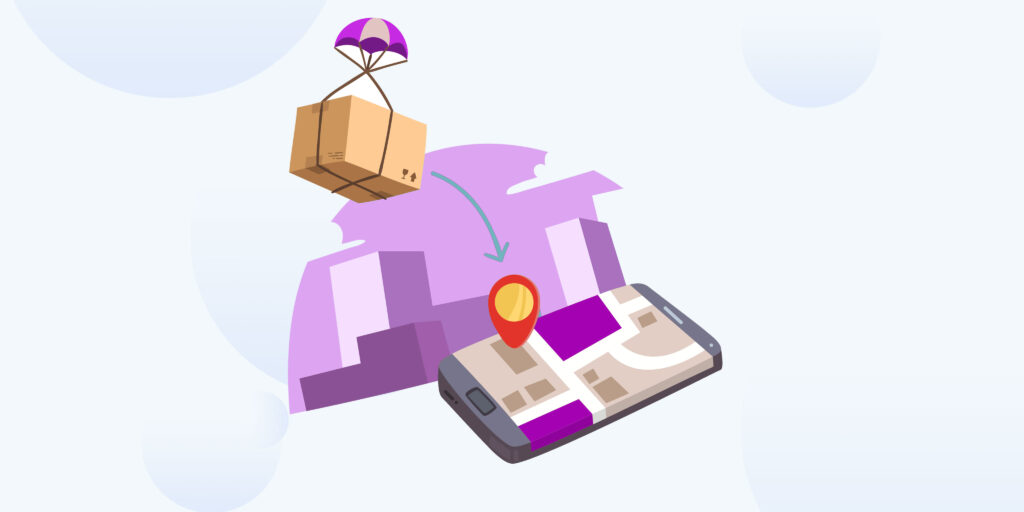
Are you looking to get into dropshipping, but feeling overwhelmed and unsure of where to start? Look no further!
This blog post will help you demystify the world of dropshipping and provide a step-by-step guide on how to start dropshipping the easy way.
We’ll cover everything from setting up a store to ensuring your customers get their orders as quickly as possible.
By the end, you’ll have all the information you need to launch your own successful dropshipping business. Let’s get started!

Dropshipping is a retail fulfilment method where a store doesn’t keep the products it sells in stock. Instead, when a store sells a product, it purchases the item from a third party and has it shipped directly to the customer.
This means the store never sees or handles the product.
In simple terms, dropshipping is an arrangement in which the seller does not hold physical inventory but instead forwards customer orders and shipment details to a supplier, who then ships the product directly to the customer.
This model is advantageous to many retailers because it eliminates the need for storage space, minimizes overhead expenses, and reduces the risk of having unsold inventory.
Additionally, the retailer can offer a wide range of products without actually stocking them, providing an easy and cost-effective way to enter the retail market.
Overall, dropshipping has become a popular method for online retailers who want to start an online business or expand their existing product lines without investing heavily in inventory or taking on the associated risk.
Dropshipping has gained popularity among entrepreneurs looking to start their own businesses. This business model offers several benefits, including:
1. Low Startup Costs: With dropshipping, you don’t have to worry about purchasing inventory upfront. You only order products from suppliers when customers make purchases from your online store. This eliminates the need for a large upfront investment in inventory, storage space, and other logistics.
2. Flexibility: Dropshipping allows you to work from anywhere, as long as you have a computer and internet connection. This makes it a great option for people who want to work from home or travel while running their business.
3. Wide Product Range: Because you don’t need to worry about managing inventory, you can offer a wide variety of products on your online store. This gives you the flexibility to sell different types of products without having to worry about keeping them in stock.
4. Scalability: As your business grows, you can easily scale up by adding new products or suppliers to your online store. This allows you to expand your business without having to worry about the logistics of managing inventory and shipping.
5. Reduced Risk: With dropshipping, you don’t have to worry about purchasing products that may not sell. You only order products from suppliers when customers make purchases from your online store. This significantly reduces the risk of holding onto unsold inventory.
Overall, dropshipping is a great option for entrepreneurs looking to start their own business with low startup costs and a lot of flexibility. .
At Console Creative, we are helping you create the best ecommerce or dropshipping website that will make your business stand out amongst your competitors as the leading business in the industry.
Click here to get a quote now
While dropshipping can seem like a perfect way to start an online business, it does come with its own set of disadvantages. Some of the biggest drawbacks to dropshipping include:
1. Low Profit Margins: Because you’re not producing or storing your own inventory, you don’t have much control over the prices you charge. This means that you’ll often have to accept lower profit margins than you would with traditional retail methods.
2. Inventory Issues: With dropshipping, you’re relying on your suppliers to handle all of the inventory and shipping. This means that you’ll have less control over the stock levels and shipping times, which can lead to customer complaints and lost sales.
3. Supplier Dependence: Your business is only as strong as your supplier relationships. If a supplier has issues with their inventory or shipping, it can cause major disruptions to your business.
4. Shipping Costs: Dropshipping can be expensive when it comes to shipping costs. You may have to pay more to ship individual items than you would if you were shipping in bulk.
5. Competition: Because dropshipping is so easy to start, it means that there’s a lot of competition out there. This can make it difficult to stand out and build a successful business.
Overall, dropshipping can be a great way to start an online business, but it’s important to be aware of the potential downsides. By understanding the disadvantages, you can make informed decisions and work to minimize any negative impacts on your business.
Dropshipping is a fulfillment method that allows online retailers to sell products without having to stock inventory. Instead, when a customer places an order, the retailer purchases the product from a third-party supplier who ships it directly to the customer.
Here’s a step-by-step breakdown of how dropshipping works:
1. The retailer sets up an online store: This can be done using platforms such as Shopify, Bigcommerce, or WooCommerce. We can as well help you set it up at Console Creative.
2. The retailer chooses which products to sell: The products can be sourced from suppliers on marketplaces like AliExpress or from independent suppliers.
3. The retailer sets the product prices: The retailer adds a markup to the wholesale price of the product to make a profit.
4. The customer places an order: When a customer orders a product, the retailer receives the payment and shipping information.
5. The retailer orders the product from the supplier: The retailer orders the product from the supplier and pays the wholesale price.
6. The supplier ships the product directly to the customer: The supplier ships the product to the customer on behalf of the retailer.
7. The customer receives the product: The customer receives the product, and the transaction is complete.
In this way, the retailer doesn’t have to worry about holding inventory, handling shipping, or managing returns and refunds. All of those aspects are handled by the supplier.
At Console Creative, we are helping you create the best ecommerce or dropshipping website that will make your business stand out amongst your competitors as the leading business in the industry.
Click here to get a quote now

If you’re interested in learning how to start a dropshipping business, there are several key steps you’ll need to take to set yourself up for success. Here are the most important steps to follow:
It’s important to narrow down your product offerings to a specific niche. This will help you stand out from competitors and make it easier to market your products.
Once you’ve chosen a niche, you’ll need to research your market to determine what products are in demand and what your target audience is looking for.
Finding a supplier who can provide you with quality products at a good price is essential to your success. Take your time to research potential suppliers and ask for samples before making a final decision.
You can use an e-commerce platform like Shopify to create your online store. Choose a professional-looking theme and make sure your website is easy to navigate.
This will involve doing keyword research and optimizing your product descriptions and meta tags.
Use social media, email marketing, and other digital marketing channels to drive traffic to your website. You can also use paid advertising to increase your visibility.
When customers place an order, your supplier will handle the shipping and fulfilment process. However, you’ll still need to handle customer service issues and ensure that orders are delivered on time.
By following these steps, you can start a successful dropshipping business and begin making money online. Just remember that like any business, it takes time and effort to achieve success.
It takes deep experience in web development to create a very attractive, search engine optimized, high converting dropshipping or ecommerce website that gets visitors to bring out their cards to make some purchases.
At Console Creative, we are helping you create the best ecommerce or dropshipping website that will make your business stand out amongst your competitors as the leading business in the industry.
Click here to get a quote now
One of the key elements to having a successful dropshipping business is finding the right products to sell. But how do you know what products are going to sell well and generate revenue?
Here are some tips for finding the right products:
1. Conduct market research: Research your target market and see what products are popular and in demand. Use tools such as Google Trends, Amazon Best Sellers, and social media platforms to identify what products are trending and being talked about.
2. Look for niche products: Find products that cater to a specific market or niche. This could be anything from pet products to eco-friendly home goods. Niche products often have a more dedicated and loyal customer base, leading to higher sales and profits.
3. Check out your competition: Look at what products your competitors are selling and see if there is room for you to offer something unique or different. Additionally, review their customer feedback and ratings to see what products are being well-received.
4. Consider the profit margin: Determine what the profit margin is for each product you’re considering selling. Look for products that have a higher profit margin, but also take into account the cost of shipping and any fees associated with the platform you’re using to sell the products.
5. Test and track your products: Once you’ve identified potential products to sell, start testing them. Create a small sample order to see how well they sell. Then, track your results and adjust your strategy as needed.
By following these steps, you can increase your chances of finding the right products to sell and building a successful dropshipping business.
Now that you have found the right products to sell, it’s time to set up your online store. Here’s a step-by-step guide to help you get started:
1. Choose your ecommerce platform – You have a lot of options when it comes to ecommerce platforms, such as Shopify, WooCommerce, Magento, and BigCommerce. Choose the one that fits your needs and budget the best.
2. Pick a domain name – Your domain name is your website’s address. Choose a domain name that is memorable and relevant to your business.
3. Design your store – Choose a theme or template that fits your brand and customize it to make it your own. Make sure your store looks professional and easy to navigate.
4. Set up your product pages – Create product pages for each item you want to sell. Make sure you include clear photos, detailed descriptions, and pricing information.
5. Choose your payment gateway – A payment gateway is what allows you to accept payments from your customers. Choose a payment gateway that is secure and reliable.
6. Set up your shipping options – Decide on your shipping rates and methods, and make sure they are clear to your customers.
7. Create policies – Establish your store policies, such as your return policy, privacy policy, and terms and conditions.
8. Test your store – Before you launch your store, test it thoroughly to make sure everything is working correctly.
Creating an online store can be time-consuming, At Console Creative, we help you create the best converting online store for your business. Get a quote here
Once you’ve set up your online store and identified the right products to sell, the next step is to start marketing your store.
1. Social Media Marketing: Use social media platforms like Facebook, Instagram, Twitter, and Pinterest to promote your store and products. Create compelling content and share it with your followers. You can also use paid advertising options like Facebook Ads and Instagram Ads to reach a wider audience.
2. Email Marketing: Build an email list of customers and send them promotional emails with special offers, discounts, and new product releases. You can also use email marketing to build customer loyalty by offering exclusive deals and rewards to your loyal customers.
3. Search Engine Optimization (SEO): Optimize your online store for search engines by using relevant keywords, meta descriptions, and title tags. This will help your store rank higher in search engine results and attract more traffic.
4. Influencer Marketing: Partner with influencers in your niche and have them promote your products on their social media platforms. This can be an effective way to reach a wider audience and generate sales.
5. Content Marketing: Create valuable content like blog posts, videos, and infographics that are related to your products and niche. This will help you attract organic traffic and build a loyal following.
By implementing these digital marketing strategies, you can promote your online store and reach your target audience.
At Console Creative, we are helping you create the best ecommerce or dropshipping website that will make your business stand out amongst your competitors as the leading business in the industry.
Click here to get a quote now
One of the biggest advantages of dropshipping is that you don’t have to worry about inventory management or shipping.
When a customer places an order on your website, you simply place an order with your supplier, who then ships the product directly to the customer.
But how do you make sure that the orders are fulfilled and shipped on time? Here are some tips to help you manage the fulfilment and shipping process:
1. Set up an automated system: Use an e-commerce platform that allows you to automate the order fulfilment process. When a customer places an order, the system should automatically send the order details to your supplier.
2. Keep track of inventory levels: Make sure you have accurate information about the inventory levels of your supplier. If a product is out of stock, you’ll need to find an alternative supplier or remove the product from your website.
3. Communicate with your supplier: Establish a good relationship with your supplier and communicate regularly. If there are any issues with the order, you’ll want to know about it as soon as possible.
4. Provide tracking information to your customers: Make sure your customers have access to tracking information so they can see when their orders will be delivered. This will also help you to manage any issues with delayed or lost shipments.
5. Manage returns and refunds: Make sure you have a clear policy for returns and refunds. If a customer is not satisfied with their purchase, you’ll need to work with your supplier to ensure the product is returned and the customer is refunded.
By following these tips, you can ensure that your dropshipping business runs smoothly and your customers are satisfied with their purchases.
At Console Creative, we are helping you create the best ecommerce or dropshipping website that will make your business stand out amongst your competitors as the leading business in the industry.
Click here to get a quote now